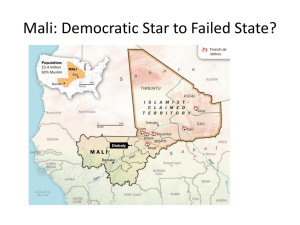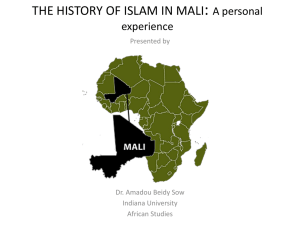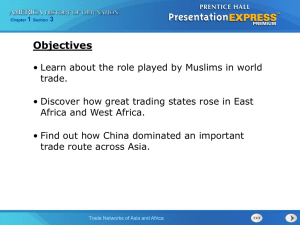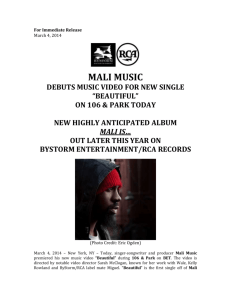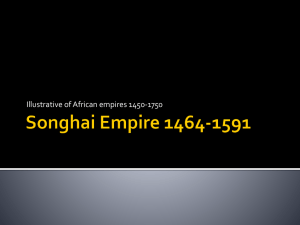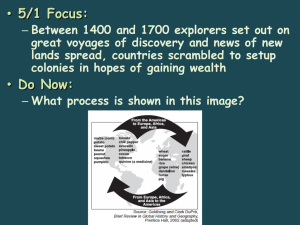Historical Narrative Lesson_Technology
advertisement
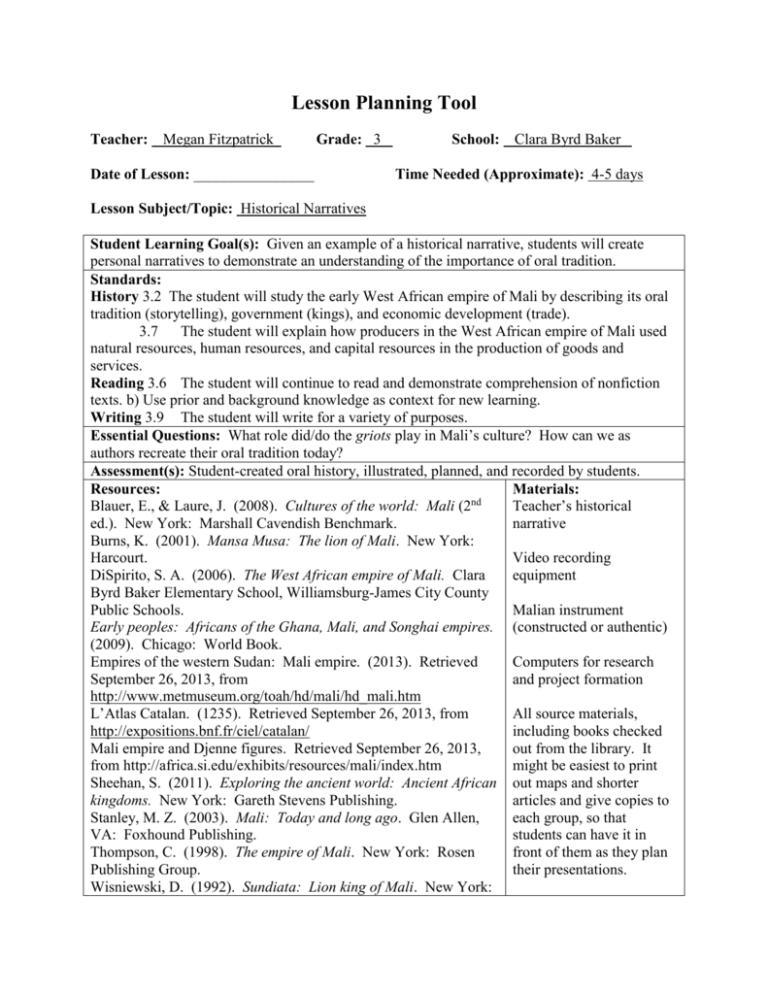
Lesson Planning Tool Teacher: Megan Fitzpatrick Grade: 3 Date of Lesson: ________________ School: Clara Byrd Baker Time Needed (Approximate): 4-5 days Lesson Subject/Topic: Historical Narratives Student Learning Goal(s): Given an example of a historical narrative, students will create personal narratives to demonstrate an understanding of the importance of oral tradition. Standards: History 3.2 The student will study the early West African empire of Mali by describing its oral tradition (storytelling), government (kings), and economic development (trade). 3.7 The student will explain how producers in the West African empire of Mali used natural resources, human resources, and capital resources in the production of goods and services. Reading 3.6 The student will continue to read and demonstrate comprehension of nonfiction texts. b) Use prior and background knowledge as context for new learning. Writing 3.9 The student will write for a variety of purposes. Essential Questions: What role did/do the griots play in Mali’s culture? How can we as authors recreate their oral tradition today? Assessment(s): Student-created oral history, illustrated, planned, and recorded by students. Resources: Materials: Blauer, E., & Laure, J. (2008). Cultures of the world: Mali (2nd Teacher’s historical ed.). New York: Marshall Cavendish Benchmark. narrative Burns, K. (2001). Mansa Musa: The lion of Mali. New York: Harcourt. Video recording DiSpirito, S. A. (2006). The West African empire of Mali. Clara equipment Byrd Baker Elementary School, Williamsburg-James City County Public Schools. Malian instrument Early peoples: Africans of the Ghana, Mali, and Songhai empires. (constructed or authentic) (2009). Chicago: World Book. Empires of the western Sudan: Mali empire. (2013). Retrieved Computers for research September 26, 2013, from and project formation http://www.metmuseum.org/toah/hd/mali/hd_mali.htm L’Atlas Catalan. (1235). Retrieved September 26, 2013, from All source materials, http://expositions.bnf.fr/ciel/catalan/ including books checked Mali empire and Djenne figures. Retrieved September 26, 2013, out from the library. It from http://africa.si.edu/exhibits/resources/mali/index.htm might be easiest to print Sheehan, S. (2011). Exploring the ancient world: Ancient African out maps and shorter kingdoms. New York: Gareth Stevens Publishing. articles and give copies to Stanley, M. Z. (2003). Mali: Today and long ago. Glen Allen, each group, so that VA: Foxhound Publishing. students can have it in Thompson, C. (1998). The empire of Mali. New York: Rosen front of them as they plan Publishing Group. their presentations. Wisniewski, D. (1992). Sundiata: Lion king of Mali. New York: Clarion Books. http://www.worldtrek.org/odyssey/teachers/malilessons.html#groits Notes: This lesson is not the beginning of the unit on ancient Mali. Students will have some knowledge already regarding its history, economy, and government. Today begins the lessons on its oral tradition, specifically storytelling by the famed griots. Extra adult support would be helpful during the filming day for the projects, as there will likely be several students who will need help. Lesson Component Engage & Hook Day 1 Learning Activity Types and Technology Options: Artifact-Based Inquiry: griot instruments, digital archives for images Plan B: Printed photos of Malian instruments Audio/Visual Presentation: Virginia DOE Podcast on Malian griots (On iTunes) Plan B: I will tell the students the same information in the video and have them complete their worksheets based off my lecture Generate Questions: Class KWL chart on a word document on the projector and/or on the document camera Plan B: Create a KWL chart on chart paper or on the chalkboard Teacher Ask students questions to remind them what we have been discussing in previous lessons: Where was the Empire of Mali? What kind of economy did they have? What kind of government ruled? Direct students’ attention to the KWL chart created at the beginning of the unit, and point out any questions relevant to today’s lesson (oral storytelling). Show students the Malian instrument, without telling them what it is. Ask them what questions or predictions they have about it, and allow students to come up and feel it. Add questions/comments to the KWL chart. Tell students you are going to give them some context by showing them a source of information. Play clip from the Virginia DOE Podcast on the Empire of Mali (Lesson 3, “The Griot”). When the clip is over, ask students if they can now tell you what the “mystery artifact” is. Add to the KWL chart. Discuss the importance of the griots to Ancient Malian culture. Ask, did your parents have all the same kinds of technology that we have now? (some might know names of older technology) What about their parents? How about when America Student Students will review information on Mali history, economy, and government. Students will participate in the class discussion about the “mystery artifact,” adding to the class KWL chart. Students will watch the video podcast, filling in information on their guided viewing protocols as they go along. Students will update the class KWL chart after viewing the video podcast. Students will discuss the changing modes of communication, beginning with modern technology and working backwards in time until they are thinking about Ancient Mali. They should reach the conclusion, was founded? (they may know that letters were used, but that it took a long time to deliver them) Explain that the Empire of Mali existed back even further than when Columbus sailed and found America. Ask how they think people communicated then. Explain that because the Malian people had no written language for a long time, the griots were responsible for passing Malian history down through the generations. Update the class KWL chart as necessary. Prompt students to discuss traditions Explain & Model in their own families and how these Day Two traditions/stories get passed down. Introduce the term historical Learning Activity Types and narrative: history in story-based Technology Options: form. Read teacher-created historical Read Text: Electronic narrative (or excerpt) about the books history of Mali. Plan B: Read aloud After reading the historical narrative, printed version of ask students for their reactions: What historical narrative kind of information was presented? Discuss: Use InterWrite (historical fact, legend) What kind of tablet to track student language was used? (dramatic, discussion of historical personal) Who was the author narrative addressing? (the people of Mali) Plan B: Keep track Tell the students that they will be of discussion on creating their own historical chalkboard or chart narratives in their own form, with a paper twist: because in Ancient Mali Generate Questions: history could not be written down, Maintain class KWL the students’ historical narratives chart on a word cannot be written either. Their document on the narratives will be in the genre projector and/or on the historical fiction, because they will document camera be telling a story from the point of view of a child from Ancient Mali. Plan B: Create a KWL chart on chart The full instruction sheet is below. Go through this with them step by paper or on the step. Ask for any questions they chalkboard might have. with scaffolding, that the people of Ancient Mali not only did not have the same technology we have today, but they also did not yet have a developed written language. Students will share personal stories with the class/their groups about family traditions. Students will share thoughts about the style of the historical narrative, including its content, purpose, and style. Students will read the assignment for the creation of a historical narrative and begin to choose a topic and a mode of presentation. Students will ask questions of the teacher regarding these instructions. Students will begin to plan, illustrate, and write about their historical narratives. Explore & Apply Days Three & Four Learning Activity Types and Technology Options: Create a picture: Illustration app or computer program Plan B: Handdrawn illustrations Create an audiorecording: Camtasia (or other video creation software available) Plan B: Students will present their drawings and stories to the class live, rather than recording first Generate Questions: Maintain class KWL chart on a word document on the projector and/or on the document camera Plan B: Create a KWL chart on chart paper or on the chalkboard Evaluate & Close Day Five Learning Activity Types and Technology Options: Present: Camtasia or Remind students that they have a lot of resources to look to for information: their notes, the class KWL chart, their guided viewing protocol, etc. They should use real facts to help them come up with ideas for their narratives. Set up laptops with online resources about Mali (listed above in resources) for students to use if the need. As they are researching and planning, walk around to help them navigate through the different texts, asking questions about their purpose in researching as they go along. Facilitate student research by answering questions and making sure students are finding accurate, relevant information to their topic, but do not get overinvolved in their creativity. When students finish their illustration and sentences, proofread with them to be sure they are saying what they want to say. As students finish, have them come to a designated section of the classroom to record their stories. Collect the illustrations. Be sure to label each audio recording and illustration to ensure they can be matched up later. Once all student projects’ are complete and recorded, the teacher will take the work home and, using the video creation software Camtasia, match each student’s audio recording and illustration. These will be compiled into a class video. Gather as a whole class. Play the prepared video and direct students to pay attention to how each person chose to describe and represent their story. Highlight several aspects of the project that showed accurate and Students will research, given resources both from texts and from online databases, provided by the teacher. Students will actively participate in researching and planning for their recording. Students will work with teachers and aides to create the final recording of their historical narratives. Students will listen attentively to the class video and pay attention to the different stories being told. other video creation software Plan B: Students will present their drawings and stories to the class live, rather than recording first Discuss: Use InterWrite tablet to track student discussion of historical narrative Plan B: Keep track of discussion on chalkboard or chart paper Generate Questions: Maintain class KWL chart on a word document on the projector and/or on the document camera Plan B: Create a KWL chart on chart paper or on the chalkboard engaging examples of Mali’s history. Remind students that they acted as griots, and ask them to write about how creating an oral story differs from creating a written story. Close by summarizing what has been learned about historical narratives and about Mali’s communication and record-keeping tactics. Congratulate students on acting as griots to keep history alive. Students will discuss, the different types of information in each project. Students will think about and record (write) how they think oral traditions differ from written ones. Creating Your Personal Historical Narrative We have learned a lot about ancient Mali’s history, economics, people, and stories. Remember that griots were responsible for remembering the history of their people and passing this information down to the next generation. There are still griots in Mali today who perform much the same job. Your job is to be a griot and tell a story that you think should be remembered and passed down. Imagine you are a child in Ancient Mali. What would your life be like? What kinds of things would you do? Pick one specific aspect and draw a detailed picture of it. Write at least three “super sentences” telling a story about your illustration. Remember that griots retold history before they could even write anything down! You will be presenting your story in a similar way. Be creative! You can write down a script, or notes, but when you present, you will have to use an oral (spoken) format. We will all be recording our stories! I will collect each drawing of the event, record your voices telling the stories, and make a video for us to watch and share our personal experiences and traditions. **Remember** Historical narratives include lots of details and use dramatic language. Be sure to use these strategies in your own writing!


